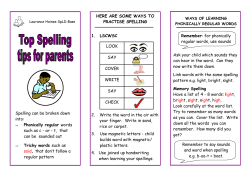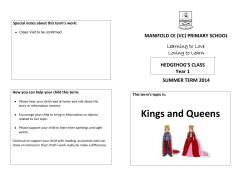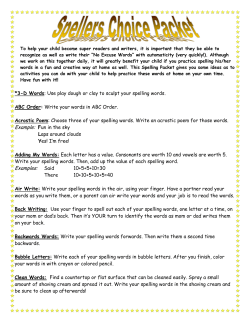
Spelling Out…
Spelling Out… Spelling Learning Strategies Children learn in variety of different ways. In order to support our dual-approach to spellings, we will be explaining the many strategies children can use to learn spellings, empowering them to become independent learners and spellers. Visual strategies - Try writing the word down in two or three different ways, in joined handwriting. This will fix the spelling in the hand. - Use a highlighter pen to draw your attention to the part of the word you need to learn. - Look for words within words (e.g. get in vegetable, lie in believe). - Use the Look, say, cover, write, check strategy. Progres Proggress …Progress Auditory strategies - Listen to the word. Break it into syllables and then identify the phonemes in each syllable (e.g. Sep-tem-ber). - When letters or parts of words are silent, say the words in an exaggerated way (e.g. k-nife, bus-i-ness) - Analogy is using words already known (e.g. could, would, should). An inclusive whole-school approach to nurturing better spellers Learning Strategies - Learning about the structure of words can help spelling. For example, find the root of a word and check whether it changes when prefixes or suffixes are added (e.g. smiling: root = smile + ing). - Mnemonics are a useful memory aid (e.g. Big Elephants Can Always Understand Small Elephants = Because). - Homophones often cause difficulties, e.g. here and hear. Learn them with other words that look the same rather than sound the same (e.g. here, where, there). - KS2 Parent Guide In this leaflet, we outline our new, dual-approach to the teaching and learning of spelling: • • Spelling patterns and rules ‘The Basics’: high-frequency/common word strategies Spelling at Bradway Primary School This year we have made spelling a priority at Bradway. Our new spelling approach works on two fronts: 1) Learning about the spelling patterns and rules to apply when attempting unfamiliar words Through this, children will feel more confident when trying to spell unfamiliar words; using new, or adventurous vocabulary will be less daunting for them. 2) Revising high-frequency words Learning by the heart the most commonly used spellings will provide a useful ‘bank’ of known vocabulary. As these words often come up in writing, children will see the accuracy of their spelling increase. This, in turn, will have a positive impact on their confidence. Spelling patterns and rules Every year group will work on a specific spelling pattern or convention for a fortnight. Within class, the rule will be taught and then, over the course of two weeks, the children will receive bite-size sessions, to reinforce the learning. A list of words that follow the pattern will be sent home. Children, in partnership with their parents/carers, can choose a personalised spelling list from these words, and learn them over the fortnight. Selecting their own spellings, allows children for whom learning spellings is a challenge, to receive that ‘full marks feeling’. It also allows children to develop the skills needed to reflect on their learning and set themselves challenges. For example, a child may find that, having reviewed the spelling list with an adult at home, they can aim to learn them all during the fortnight. However, the next spelling rule may be one that the child finds more challenging, and so they may agree that learning 10 words would be a realistic target. In both these cases, children can receive full marks, if they spell their selected words correctly. Each class will have a spelling display detailing the spelling pattern of the fortnight, together with useful ‘spelling learning strategies’ (see overleaf) for use when learning unfamiliar words. Children are invited to continue investigating the pattern at home, and to share any evidence of progress with their class teacher – examples include photographs, games, word searches/crosswords or more traditional ‘have-a-go lists’, which can all then be added to the display board. High Frequency Words – ‘Mopping Up’ the Basics Spelling Lists Each fortnight, parents/carers can help their child build a personalised spelling list from a selection of words linked to their class’ focus spelling pattern or rule. As well as learning spelling patterns and rules, it is also important that children are secure with the spelling of common, high-frequency words (spellings of words which are often used).This is where the second part of our spelling approach comes in. All pupils will be assessed on key-words when entering their new class. From this, we will be able to identify each child’s individual gaps. Children will then work on these spellings, within school - using ‘Zappers’ at lower KS2, and an ipad APP at upper KS2. Your child’s progress is recorded in their English book and tracked through school, so children can see how they are progressing.
© Copyright 2025











